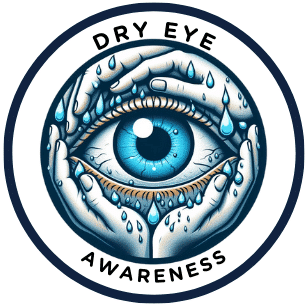
More than just a fleeting nuisance, Dry Eye Syndrome (DES) is an eye condition that arises when the eyes don’t lubricate themselves adequately, leading to a range of uncomfortable symptoms. This condition affects millions globally, and it’s not particular about who it troubles—everyone from young adults glued to their screens to the elderly can experience it.
Awareness is crucial. Why? Because catching the symptoms early on is key to preventing potential long-term impacts on vision and overall eye comfort. The eyes are not just windows to the soul; they’re our primary navigators through life. Ensuring their health means sustaining the quality of life we all cherish.
Symptoms of Dry Eye Syndrome might seem inconsequential at first, but without proper attention, they can escalate. This can lead to more than mere discomfort; in severe cases, it affects vision and can significantly hinder day-to-day life. Imagine being amidst a task only to be interrupted by the persistent feeling that something’s amiss with your eyes—that’s DES casting its shadow.
Moving forward, I’ll introduce you to some of the hallmark signs of DES. Recognizing these symptoms is your first defense against the syndrome. I believe in empowerment through knowledge, which means teaching you the signs to look out for will equip you to seek the necessary help before any serious issues arise.
Common Signs of Dry Eye Syndrome
If you’ve ever felt like there’s sand in your eyes but no actual sand to blame, you might be experiencing dry eye syndrome. This condition sends a clear signal when environmental, lifestyle, and biological factors disrupt the delicate balance of tear production. The symptoms are varied, but there are some common ones to watch out for.
One telltale sign of dry eye syndrome is a persistent sensation of dryness or grittiness. It’s as if your eyes can’t stay lubricated, no matter how much you blink. If your eyes often look redder than a sunset, this irritation could be a cry for help from your overworked eyes.

Screen time doesn’t just eat hours; it can consume your eye comfort, too. Eye strain from staring at digital devices for long periods might suggest you’re dealing with dry eye syndrome. Add to that the difficulty you may face when driving at night, due to glare and reduced vision, and you’ve got compelling reasons to pay attention to your eye health.
Light sensitivity is another red flag. If you find yourself squinting or turning off lights to ease discomfort, it’s time to listen to your eyes. When these common symptoms start to interfere with your daily life, it’s crucial to understand what might be causing the upset. That way, you can seek effective treatment and prevent the symptoms from worsening.
Underlying Factors: What Causes Dry Eye Syndrome

You might wonder why some individuals seem to be more affected by dry eye syndrome (DES) than others. The tear film on the surface of the eye plays a critical role in keeping your eyes comfortable and healthy. It’s a finely tuned balance, and when it’s disrupted, DES can result.
Environmental factors are significant players in the development of DES. Low humidity environments, exposure to wind, and even air conditioning can all reduce moisture levels in your eyes. If you live in an area with a dry climate or you spend a lot of time in heated or air-conditioned spaces, your risk of experiencing DES symptoms increases.
The digital era has brought many advantages, but it’s also increased the amount of time many of us spend in front of screens. This screen time has a documented impact on blink rates, leading to less frequent blinking and, consequently, increased tear evaporation. If you find your job or hobbies have you staring at a screen for extended periods, it could be contributing to your dry eye symptoms.
Certain medical conditions and medications can also predispose you to DES. Autoimmune disorders, such as Sjogren’s syndrome, and medications like antihistamines or blood pressure drugs, can reduce tear production or alter the composition of your tears. If you’re managing a health condition or taking medication, it’s worth discussing the connection to dry eye symptoms with your healthcare provider.

Age and lifestyle also cannot be overlooked. As we age, tear production naturally decreases, which is why older adults more commonly experience DES. Moreover, diet and smoking can influence the health of your eyes. For instance, a diet low in omega-3 fatty acids might contribute to dryer eyes, while smoking can exacerbate irritation and dryness.
Now that you’re aware of what might be causing your dry eye symptoms, let’s discuss the next steps towards relief and better eye health. Reaching out for professional advice is paramount, and I’m going to guide you through this process in the following section.
When and Where to Seek Help: Addressing Dry Eye Syndrome
If you’re experiencing persistent symptoms consistent with dry eye syndrome, I urge you to make an appointment with an eye care professional. It’s not just about comfort; it’s about safeguarding one of your most vital senses. An optometrist or an ophthalmologist will conduct a detailed examination to determine the severity of your condition and discuss the appropriate next steps.
During a dry eye evaluation, expect to answer questions about your eye health history and symptoms. Tests may explore the quality and quantity of your tears, or how well your eyes distribute and maintain moisture. Based on the findings, treatment options could range from over-the-counter remedies like artificial tears to prescription medications, or even minor surgical procedures in more severe cases.
Aside from medical interventions, lifestyle changes can significantly impact DES management. This might include altering your home or work environment to reduce air movement around your eyes, increasing humidity levels, or taking frequent breaks during long periods of screen time to rest your eyes.
Long-term management will likely involve a combination of treatments tailored to your specific needs. Be prepared to play an active role in managing DES. Follow-up appointments are important to monitor your eyes’ health and adjust treatments as necessary.
Remember, you have a pivotal role in your own eye health. By understanding when to seek help and what options are available, you gain the power to not just manage dry eye syndrome, but to enhance your overall quality of life. Your vision is precious—protect it proactively.
